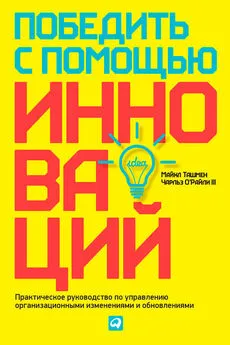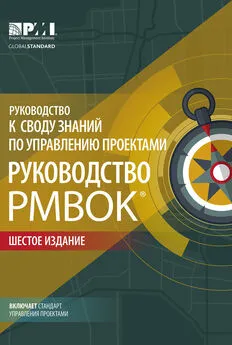Чарльз О'Райли III - Победить с помощью инноваций. Практическое руководство по управлению организационными изменениями и обновлениями
- Название:Победить с помощью инноваций. Практическое руководство по управлению организационными изменениями и обновлениями
- Автор:
- Жанр:
- Издательство:Array Литагент «Альпина»
- Год:2014
- Город:Москва
- ISBN:978-5-9614-3497-2
- Рейтинг:
- Избранное:Добавить в избранное
-
Отзывы:
-
Ваша оценка:
Чарльз О'Райли III - Победить с помощью инноваций. Практическое руководство по управлению организационными изменениями и обновлениями краткое содержание
Победить с помощью инноваций. Практическое руководство по управлению организационными изменениями и обновлениями - читать онлайн бесплатно ознакомительный отрывок
Интервал:
Закладка:
Nadler D., M. Gerstein and R. Shaw. 1992. Organization Architecture. San Francisco: Jossey-Bass.
Nadler D., R. Shaw and E. Walton. 1995. Discontinuous Change. San Francisco: Jossey-Bass.
Nelson R. 1995. Recent Evolutionary Theorizing About Economic Change. Journal of Economic Literature 33: р. 48–90.
Nelson R. and S. Winter. 1982. An Evolutionary Theory of Economic Change. Cambridge, Mass.: Harvard University Press.
Noble D. 1984. Forces of Production. New York: Knopf.
Nohria N. and R. Eccles (eds.). 1992. Networks and Organizations. Boston: Harvard Business School Press.
Nonaka I. 1988a. Creating Order Out of Chaos: Self Renewal in Japanese Firms. California Management Review 30, no. 3: р. 57–73.
Nonaka I. 1988b. Toward Middle-Up-Down Management: Accelerating Information Creation. Sloan Management Review (Spring): р. 9–18.
Nonaka I. 1990. Redundant, Overlapping Organization: A Japanese Approach to Innovation. California Management Review 32: р. 27–38.
Nonaka I. 1993. The Knowledge Creating Company. New York: Oxford University Press.
O’Reilly С. 1989. Corporations, Culture and Commitment: Motivation and Social Control in Organizations. California Management Review 31: р. 24–38.
O’Reilly С. 1997. Organization Culture and Managing Innovation. Manuscript.
O’Reilly C. and J. Chatham. 1986. Organizational Commitment and Psychological Attachment: The Effects of Compliance, Identification, and Internalization on Prosocial Behavior. Journal of Applied Psychology 71: р. 492–499.
O’Reilly C. and J. Chatham. 1995. Working Smarter and Harder: A Study of Managerial Success. Administrative Science Quarterly 39: р. 603–627.
O’Reilly C. and J. Chatham. 1996. Culture as Social Control: Corporations, Cults, and Commitment. In: B. Staw and L. Cummings (eds.), Research in Organization Behavior . Greenwich, Conn.: JAI Press.
O’Reilly C., D. Caldwell and W. Barnett. 1989. Work Group Demography, Social Integration and Turnover. Administrative Science Quarterly 34: р. 21–37.
O’Reilly C., J. Chatman and D. Caldwell. 1991. People and Organizational Culture. Academy of Management Journal 34: р. 487–516.
O’Reilly C., R. Snyder and J. Booth. 1993. Effects of Executive Team Demography and Organizational Change. In: G. Huber and W. Glick (eds.), Organizational Design and Change . New York: Oxford University Press.
O’Reilly C. and B. Weitz. 1980. Managing Marginal Employees: The Use of Warnings and Dismissals. Administrative Science Quarterly 25: р. 467–484.
Pascale R. 1990. Managing on the Edge. New York: Simon & Schuster.
Perrow C. 1970. Organizational Analysis. Belmont, Calif.: Wadsworth.
Peters Т. and R. Waterman. 1983. In Search of Excellence. New York: Free Press.
Pettigrew A. 1985. The Awakening Giant: Continuity and Change at ICI. Oxford, England: Basil Blackwell.
Pettigrew A. and R. Whipp. 1991. Managing Change for Competitive Success. Oxford, England: Basil Blackwell.
Pfeffer J. 1981. Management as Symbolic Action. In: B. Staw and L. Cummings (eds.), Research in Organizational Behavior . Greenwich, Conn.: JAI Press.
Pfeffer J. 1992a. Managing with Power. Boston: Harvard Business School Press.
Pfeffer J. 1992b. Understanding Power in Organizations. California Management Review (Winter): р. 29–50.
Pfeffer J. 1994. Competitive Advantage through People. Boston: Harvard Business School Press.
Porter M. 1980. Competitive Strategy: Techniques for Analyzing Industries. New York: Free Press.
Prahalad С. 1993. The Role of Core Competencies in the Corporation. Research and Technology Management (November – December): р. 40–47.
Quinn J. 1992. Intelligent Enterprise. New York: Free Press.
Quinn R. and K. Cameron. 1983. Organization Life Cycles and Shifting Criteria of Effectiveness. Management Science 29: р. 33–51.
Quinn R. and K. Cameron. 1988. Paradox and Transformation. Cambridge, Mass.: Ballinger Publications.
Redding G. 1975. International Cultural Differences. Aldershot, England: Dartmouth.
Robello K., P. Burrows and I. Sager. 1996. The Fall of an American Icon. Business Week, February 5.
Roberts E. and C. Berry. 1985. Entering New Businesses: Selecting Strategies for Success. Sloan Management Review (Spring): р. 3–17.
Romanelli E. and M. Tushman. 1994. Organization Transformation as Punctuated Equilibrium. Academy of Management Journal 37: р. 1141–1166.
Rosenbloom D. and C. Christensen. 1994. Technological Discontinuities, Organization Capabilities, and Strategic Commitments. Industry and Corporate Change 3: р. 655–686.
Rosenkopf L. and M. Tushman. 1994. The Coevolution of Technology and Organization. In: J. Baum and J. Singh (eds.), Evolutionary Dynamics of Organizations . New York: Oxford University Press.
Ross L. and R. Nisbett. 1991. The Person and the Situation: Perspectives of Social Psychology. New York: McGraw-Hill.
Rousseau D. 1995. Psychological Contracts in Organizations. Thousand Oaks, Calif.: Sage.
Royston G. and C. Hinings. 1993. Understanding Strategic Change: The Contribution of Archetypes. Academy of Management Journal 30, no. 5: р. 1052–1081.
Sager I. 1995a. The View from IBM. Business Week, October 30.
Sager I. 1995b. We Won’t Stop… Until We Find Our Way Back. Business Week, May 5.
Sager I. and A. Cortese. 1994. Lou Gerstner Unveils His Battle Plan. Business Week, April 4.
Sakakibara K. and E. Westney. 1991. Japan’s Management of Global Innovation: Technology Management Crossing Borders. In: N. Rosenberg, R. Landau and D. Mowery (eds.), Technology and the Wealth of Nations . New York: Oxford University Press.
Sanderson S. and M. Uzumeri. 1995. Product Platforms and Dominant Designs: The Case of Sony’s Walkman. Research Policy 24: р. 583–607.
Sastry A. 1997. Problems and Paradoxes in a Theoretical Model of Punctuated Organization Change. Administrative Science Quarterly 42 , no. 2: р. 237–275.
Schares G. 1993. Percy Barnevik’s Global Crusade. Business Week Enterprise.
Schein E. 1977. Process Consultation. Reading, Mass.: Addison-Wesley.
Schein E. 1985. Organizational Culture and Leadership: A Dynamic View. San Francisco: Jossey-Bass.
Schein E. 1996. Culture: The Missing Concept in Organization Studies . Administrative Science Quarterly 41, no. 2: р. 229–240.
Schiller Z. 1995. The Revolving Door at Rubbermaid. Business Week. September 18.
Schoonhoven K. and K. Eisenhardt. 1990. Managing Complexity in High Technology Organizations. New York: Oxford University Press.
Schoonhoven K., K. Eisenhardt and K. Lyman. 1990. Speeding Products to Market. Administrative Science Quarterly 35, no. 1: р. 177–207.
Sellars P. 1993. Companies That Serve You Best. Fortune, May 31.
Sellars P. 1995. Sears: In with the New: Out with the Old. Fortune, October 16.
Senge P. 1990. The Fifth Discipline. New York: Doubleday.
Sherman S. 1993. Andy Grove: How Intel Makes Spending Pay Off. Fortune, February 22.
Sherman S. 1994. Is He Too Cautious to Save IBM. Fortune, October 3.
Smith D. and R. Alexander. 1990. Fumbling the Future. New York: Harper.
Smith M. R. and L. Marx. 1994. Does Technology Drive History? Boston: MIT Press.
Smith P. and M. Ford. 1994. Social Psychology Across Cultures. Boston: & Bacon.
Spender J. С. 1989. Industry Recipes: An Enquiry into the Nature of Managerial Judgment. New York: Blackwell.
Stack J. 1992. The Great Game of Business. New York: Currency/Doubleday.
Stewart T. 1990. A New Way to Wake Up a Giant. Fortune, October 22.
Stewart T. 1994. How to Lead a Revolution. Fortune. November 28.
Stewart T. 1996. 3M Fights Back. Fortune. February 5.
Strebel P. 1992. Breakpoints: How Managers Exploit Radical Business Change. Boston: Harvard Business School Press.
Strom S. 1992a. Further Prescriptions for the Convalescent Sears. New York Times. October 10.
Strom S. 1992b. Signs of Life at Sears, Roebuck. New York Times. October 25.
Taylor W. 1991. The Logic of Global Business: An Interview with ABB’s Percy Barnevik. Harvard Business Review (March-April): р. 91–105.
Taylor W. 1993. Message and Muscle: An Interview with Swatch Titan Nicholas Hayek. Harvard Business Review (March-April): р. 99–110.
Teece D. 1987a. Capturing Value from Technological Innovation: Integration, Strategic Partnering, and Licensing Decisions. In: B. Guile and H. Brooks (eds.), Technology and Global Industry .
Teece D. 1987b. Profiting from Technological Innovation. In: D. Teece (ed.), The Competitive Challenge . New York: Harper & Row.
Teece D. and G. Pisano. 1994. Dynamic Capabilities of Firms. Industry and Corporate Change 3: р. 537–556.
Thompson J. 1967. Organizations in Action. New York: McGraw-Hill.
Tichy N. 1983. Managing Strategic Change. New York: Wiley.
Tichy N. and S. Sherman. 1993a. Control Your Destiny or Somebody Else Will. New York: Currency/Doubleday.
Tichy N. and S. Sherman. 1993b. Jack Welch’s Lessons for Success. Fortune, January 25.
Tomsho R. 1992. Worm Turns Out to Have Many Uses Few Can Appreciate. The Wall Street Journal. March 4.
Tushman M. 1978. Task Characteristics and Technical Communication in R&D. Academy of Management Journal 21: р. 624–645.
Tushman M. and P. Anderson. 1986. Technological Discontinuities and Organization Environments. Administrative Science Quarterly 31: р. 439–465.
Tushman M. and D. Nadler. 1978. Information Processing as an Integrating Concept in Organization Design. Academy of Management Review 3: р. 613–624.
Tushman M. and D. Nadler. 1986. Organizing for Innovation. California Management Review 28, no. 3: р. 74–92.
Tushman M. and E. Romanelli. 1985. Organization Evolution: A Metamorphosis Model of Convergence and Reorientation. In: B. Staw and L. Cummings (eds.), Research in Organization Behavior 7. Greenwich, Conn.: JAI Press.
Tushman M. and L. Rosenkopf. 1992. On the Organizational Determinants of Technological Change: Towards a Sociology of Technological Evolution. In: B. Staw and L. Cummings (eds.), Research in Organization Behavior 14. Conn.: JAl Press.
Tushman M., P. Anderson and C. O’Reilly. 1997. Technology Cycles, Innovation Streams and Ambidextrous Organizations. In: M. Tushman and P. Anderson (eds.), Strategic Managing Innovation . New York: Oxford University Press.
Tushman M., W. Newman and E. Romanelli. 1986. Convergence and Upheaval: Managing the Unsteady Pace of Organizational Evolution. California Management Review (Fall): р. 29–44.
Tyre M. and W. Orlikowski. 1993. Exploiting Opportunities for Technological Improvement in Organizations. Sloan Management Review (Fall): р. 13–26.
Utterback J. 1994. Mastering the Dynamics of Innovation. Boston: Harvard Business School Press.
Van de Ven A. and R. Drazin. 1985. The Concept of Fit in Contingency Theory. In: B. Staw and L. Cummings (eds.), Research in Organization Behavior 4. Greenwich, Conn.: JAI Press.
Читать дальшеИнтервал:
Закладка:










